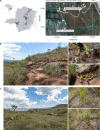Microbiomes of Velloziaceae from phosphorus-impoverished soils of the campos rupestres, a biodiversity hotspot
- PMID: 31366912
- PMCID: PMC6668480
- DOI: 10.1038/s41597-019-0141-3
Microbiomes of Velloziaceae from phosphorus-impoverished soils of the campos rupestres, a biodiversity hotspot
Abstract
The rocky, seasonally-dry and nutrient-impoverished soils of the Brazilian campos rupestres impose severe growth-limiting conditions on plants. Species of a dominant plant family, Velloziaceae, are highly specialized to low-nutrient conditions and seasonal water availability of this environment, where phosphorus (P) is the key limiting nutrient. Despite plant-microbe associations playing critical roles in stressful ecosystems, the contribution of these interactions in the campos rupestres remains poorly studied. Here we present the first microbiome data of Velloziaceae spp. thriving in contrasting substrates of campos rupestres. We assessed the microbiomes of Vellozia epidendroides, which occupies shallow patches of soil, and Barbacenia macrantha, growing on exposed rocks. The prokaryotic and fungal profiles were assessed by rRNA barcode sequencing of epiphytic and endophytic compartments of roots, stems, leaves and surrounding soil/rocks. We also generated root and substrate (rock/soil)-associated metagenomes of each plant species. We foresee that these data will contribute to decipher how the microbiome contributes to plant functioning in the campos rupestres, and to unravel new strategies for improved crop productivity in stressful environments.
Conflict of interest statement
The authors declare no competing interests.
Figures




References
-
- Oliveira Rafael S., Abrahão Anna, Pereira Caio, Teodoro Grazielle S., Brum Mauro, Alcantara Suzana, Lambers Hans. Ecology and Conservation of Mountaintop grasslands in Brazil. Cham: Springer International Publishing; 2016. Ecophysiology of Campos Rupestres Plants; pp. 227–272.
-
- Magalhães Junior Antônio Pereira, de Paula Barros Luiz Fernando, Felippe Miguel Fernandes. World Geomorphological Landscapes. Dordrecht: Springer Netherlands; 2015. Southern Serra do Espinhaço: The Impressive Plateau of Quartzite Ridges; pp. 359–370.
-
- Silveira FAO, et al. Ecology and evolution of plant diversity in the endangered campo rupestre: a neglected conservation priority. Plant Soil. 2016;403:129–152. doi: 10.1007/s11104-015-2637-8. - DOI
-
- Abrahão, A. et al. Soil types select for plants with matching nutrient-acquisition and -use traits in hyperdiverse and severely nutrient-impoverished campos rupestres and cerrado in Central Brazil. J. Ecol.107, 1302–1316 (2018).
Publication types
MeSH terms
Substances
Grants and funding
- No. DE-AC02-05CH11231/DOE | Office of Science (SC)/International
- No. DE-AC02-05CH11231/DOE | Office of Science (SC)/International
- No. DE-AC02-05CH11231/DOE | Office of Science (SC)/International
- No. DE-AC02-05CH11231/DOE | Office of Science (SC)/International
- No. DE-AC02-05CH11231/DOE | Office of Science (SC)/International
- No. DE-AC02-05CH11231/DOE | Office of Science (SC)/International
- No. DE-AC02-05CH11231/DOE | Office of Science (SC)/International
- No. DE-AC02-05CH11231/DOE | Office of Science (SC)/International
- No. DE-AC02-05CH11231/DOE | Office of Science (SC)/International
- No. DE-AC02-05CH11231/DOE | Office of Science (SC)/International
- No. DE-AC02-05CH11231/DOE | Office of Science (SC)/International
- No. DE-AC02-05CH11231/DOE | Office of Science (SC)/International
- No. DE-AC02-05CH11231/DOE | Office of Science (SC)/International
- No. DE-AC02-05CH11231/DOE | Office of Science (SC)/International
- No. DE-AC02-05CH11231/DOE | Office of Science (SC)/International
LinkOut - more resources
Full Text Sources
Miscellaneous

